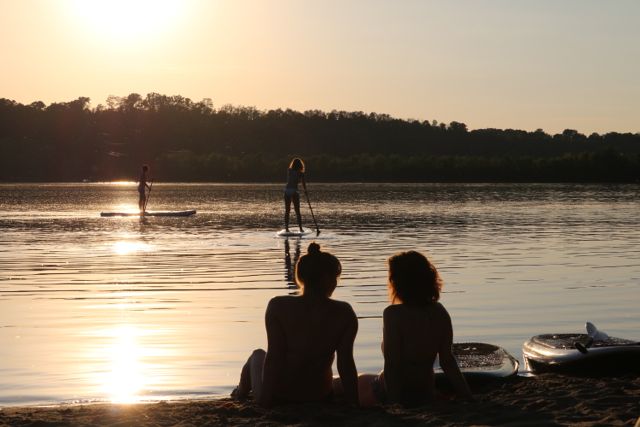Stand-Up Paddleboarding Basics

Stand-up paddleboarding (SUP) originated from the surfing culture when someone decided to add a paddle to their surfboard so there wasn’t the constant dependency on waves. The idea took off and has spread around the world.
(For more on why paddleboarding is so popular, read: The Staying Power of SUP)
SUP has become its own paddling niche. It’s been adapted by yoga practitioners, ocean surf riders, competitive racers and, of course, folks just wanting a fun, relaxing outing on their favorite body of water.
If SUP is something you’ve been wanting to try, too, here are some tips to get you started:
The basic concept of SUP is to stand on a paddleboard and glide across the water, using a long stand-up paddle to propel and steer you.
SUP Tip #1: Stay Calm and Engaged
While you paddle, stay engaged through your core. Keep your knees slightly bent and your feet in a shoulder-width stance. And most importantly—stay relaxed! Take deep breaths and remain calm. The calmer you are, the easier it is to keep the board stable, and the easier it is to move and sway with the water.
Stand Up on Your Paddleboard
- Find some calm water to start out.
- Climb on your board, facing the nose and kneeling in the center. Keep your knees about shoulder-width apart for good balance. Place your paddle across the board far enough in front of your knees so you can easily grab it or rest your hands on it.
- Take a deep breath. Relax. Feel the water. Take a look at your surroundings. Feel free to paddle around on your knees for a while.
- From kneeling, gently roll your toes under, place one foot on the board and then the other. Grab your paddle while you stand up.
SUP Tip # 2: Stay Relaxed
Rest your hands on the paddle while rolling your toes and planting your feet. Keep your knees bent, feet shoulder-width apart. Stay relaxed and take a couple more deep breaths. Have fun!
SUP Tip #3: Get Your Board to Plane
As the board planes on the water (starts to move forward), it becomes more stable. One option is to take a few strokes while you’re still kneeling, then stand while the board is planing.
Now to get moving…
The Forward SUP Stroke
- Stay relaxed and keep your knees bent. This will keep your body from becoming rigid and locked. You’ll have better balance and more mobility on your board. Try to feel your board moving with the water.
- Stretch your lower arm out and use your top hand to guide the paddle. Place the blade in the water a comfortable distance out in front, next to your board.
SUP Tip #4: Be Sure Your Paddle is Facing the Right Direction
The bend in the paddle blade should angle toward you. It seems counter-intuitive, but it’ll give you a smoother, easier stroke as you…
3. Pull the blade through the water while you bend at the waist. Finish your stroke as the blade reaches your feet. Pull it out of the water and reach again.
Be patient! There’s no rush. Just relax and enjoy cruising across the water.
Happy paddling!
What paddling questions can we can help with today? Call or email our Wisconsin-based customer service team: 715-755-3405 • sales@aquabound.com
More for you…





